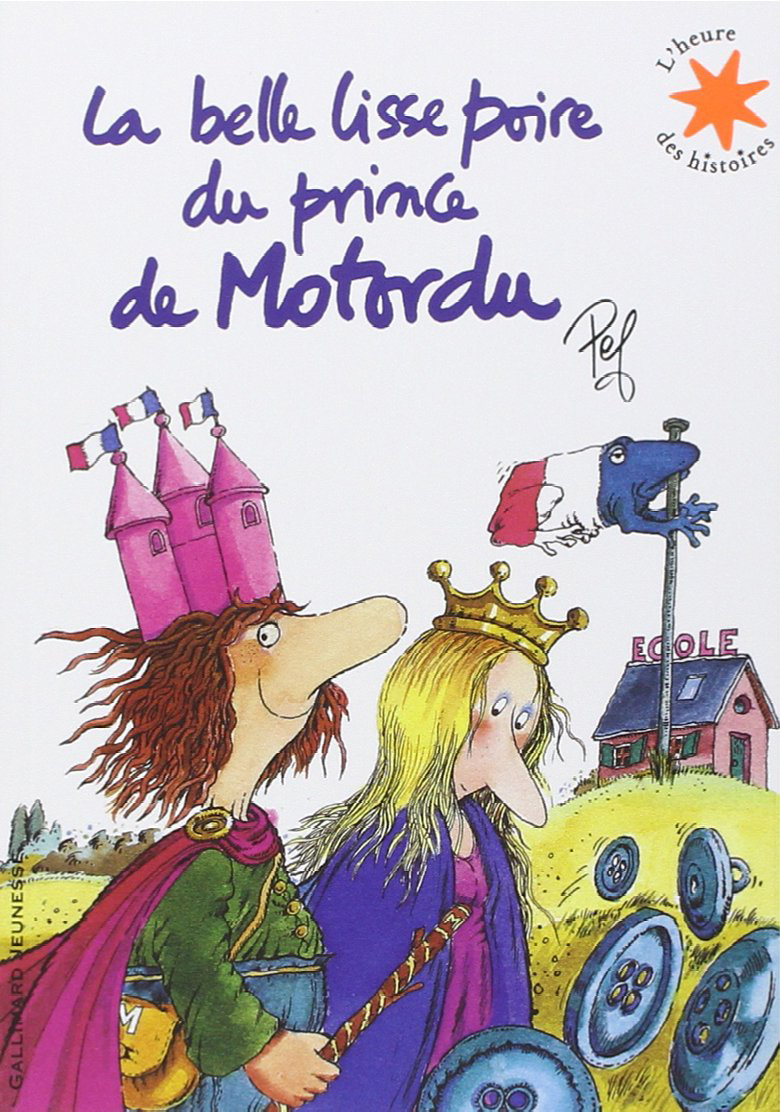 by Pef
by Pef
Le jeune prince de Motordu habite un magnifique chapeau. Avec ses coussins, il y joue aux tartes dans la grande salle à danger. Un jour, une jeune institutrice, la princesse Dézécolle, l’invite à retourner en classe pour remettre le langage à l’endroit.
Strategies/Skills Used
Reading Strategy 3: Figure out unknown words.
Reading Strategy 5: Make mental pictures.
Reading Strategy 6: Connect what you read with what you already know.
Reading Strategy 7: Determine the most important ideas and events and the relationship between them.
Reading Strategy 9: Identify and interpret literary elements in different genres.
Reading Strategy 10: Summarize what has been read.
Reading Strategy 11: Make inferences and draw conclusions.
Reading Strategy 12: Reflect and respond.
Writing Skill 1: I generate ideas in a variety of ways.
Writing Skill 2: I organize my ideas based on my purpose for writing.
Writing Skill 5: I carefully choose the most effective words to express my ideas.
Writing Skill 8: I re-read, reflect, revise and edit.
 TEACHING THE ACTIVITY: PRE-READING
TEACHING THE ACTIVITY: PRE-READING
 (1) Project a picture of the original book cover, with the title of the book removed.
(1) Project a picture of the original book cover, with the title of the book removed.
(2) Ask students the following questions: Que voyez-vous? (What do you see?) Que pensez-vous est la nature de cette histoire? (What do you think this story is about?)
 (3) Project the second image/version of the book cover (from the PDF in step 1). Have students play “Jouer aux sept différences” to find the seven differences between the two images. Students will use the Venn Diagram strategy and use the graphic organizer Faisons des comparaisons to record their thinking. Based on the differences found, bring their attention to the idea of play on words, “les mots tordus.” Invite students to identify and write down “les mots tordus” represented on the original book cover: Chateau (castle) – chapeau (hat) – crapeau (toad) – drapeau (flag) – boutons (buttons) – moutons (sheep).
(3) Project the second image/version of the book cover (from the PDF in step 1). Have students play “Jouer aux sept différences” to find the seven differences between the two images. Students will use the Venn Diagram strategy and use the graphic organizer Faisons des comparaisons to record their thinking. Based on the differences found, bring their attention to the idea of play on words, “les mots tordus.” Invite students to identify and write down “les mots tordus” represented on the original book cover: Chateau (castle) – chapeau (hat) – crapeau (toad) – drapeau (flag) – boutons (buttons) – moutons (sheep).
 (4) Continue to work the idea of “les mots tordus” by having students play Le jeu des mots tordus. (Answers are provided on the second page.)
(4) Continue to work the idea of “les mots tordus” by having students play Le jeu des mots tordus. (Answers are provided on the second page.)
 (5) Use the Place Mat strategy in table groups to brainstorm words and ideas for a possible title to this strange story. Have groups discuss their ideas and select the best one to share with the class, as the results are often entertaining. Following this, reveal and explain the actual title of the book, La belle lisse poire du prince de Motordu.
(5) Use the Place Mat strategy in table groups to brainstorm words and ideas for a possible title to this strange story. Have groups discuss their ideas and select the best one to share with the class, as the results are often entertaining. Following this, reveal and explain the actual title of the book, La belle lisse poire du prince de Motordu.
 TEACHING THE ACTIVITY: DURING READING
TEACHING THE ACTIVITY: DURING READING
(6) Provide a copy of the story to each student. Read the story out loud to the students. As they follow along, use the stress and intonation of your voice to draw their attention to “les mots tordus.” Have students highlight or underline “les mots tordus.” Students will then write the “correct” word above the highlighted “mot tordu.” As you go along, discuss what kind of words “les mots tordus” and “the correct words” are (e.g. rhyming words, rhyming sounds, or one letter has been dropped/added to make a new word).
(7) Stop reading at “Sa mère essaya de le convaincre” and have students put their text away so that they don’t read any further. Now, change all the mots tordus in the following paragraph or two into the “correct words” and project a copy of this for the students to see. Tell the students that the editor made a mistake and corrected Pef’s (the author’s) words by mistake. Have students work in small groups to switch the words back into “mots tordus,” the way they think Pef would have wanted.
(8) Have groups read their version of this part of the story to the class. Using the strategy Concept Attainment (see: Beyond Monet, Barrie Bennett), and without explaining why, place each story under either column A (compréhensible) or B (non-compréhensible) after they are read aloud. The teacher will then invite a discussion to figure out why the texts have been placed accordingly. Lead students to identify the texts that are comprehensible and those that are not. Discuss what steps or tips are needed in order to invent an effective text in “mots tordus.” Record the steps or tips on the board, as you will need to refer back to them later, post-reading, when students are asked to write their own story.
(9) Finish reading the story, continuing to highlight “les mots tordus” and identify their equivalents.
 TEACHING THE ACTIVITY: POST-READING
TEACHING THE ACTIVITY: POST-READING
(10) Using the Plot Profile strategy and any of the Tableau de compréhension or Cycle de l’histoire Graphic Organizers, have students plan out and create the sequel to La belle lisse poire du prince de Motordu with the Prince de Motordu in his new role as a father: “Le prince de Motordu Papa.” (This can be done individually or in small groups.)
(11) Brainstorm a list of possible vocabulary that students can use in their story. Help students create a list of vocabulary words related to domestic chores and baby care that the Prince de Motordu Papa may now have to do. Brainstorm a word bank of possible “mots tordus” that could be used in their place.
(12) Create an evaluation rubric for this project along with the class. Be sure to have students incorporate a minimum number of “mots tordus,” illustrate parts of the story and identify the “correct” words for “les mots tordus” in their final copy of the story.
(13) Have students share their stories with peers or buddy classes.
(14) Read the actual sequel, Mortordu papa by Pef, aloud to your class once they have completed their own stories. Allow them the opportunity to reflect and compare their own version of the story to this one.
 TEACHING THE ACTIVITY: POST-READING EXTENSIONS
TEACHING THE ACTIVITY: POST-READING EXTENSIONS
Select any of the post-reading activity options below, singly or in combination:
(15) Create a different sequel to the story, such as “L’ami vert cerf du prince de Motordu” – the Prince of Motordu’s birthday (anniversaire).
(16) Have students select six to ten artifacts that relate to the story and explain their relevance through a Paper Bag Presentation.
(17) Using the Judge and Jury strategy, initiate a role-play of a courtroom scene to cross-examine Pef for insulting or misusing the French language.
Faire Le procès de Pef pour outrage à la langue!
- ceux qui défendent (les lecteurs, les enfants, un poète…)
- ceux qui attaquent (un prof, un parent, au auteur, un dictionnaire…)
- pièces de conviction objets tordus dangeureux…zéro en dictée
(18) Invent some “tartes postales” (post tarts/cards).
(19) Invent some “objets tordus” (twisted objects), such as “une chaussure à ballons hauts” (a high-ballooned (heeled) shoe) and set up an art gallery exhibit.